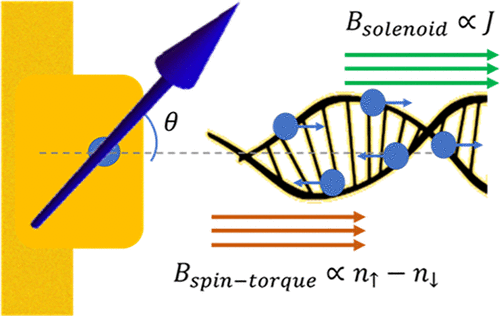当前位置:
X-MOL 学术
›
J. Am. Chem. Soc.
›
论文详情
Our official English website, www.x-mol.net, welcomes your
feedback! (Note: you will need to create a separate account there.)
Spinterface Origin for the Chirality-Induced Spin-Selectivity Effect
Journal of the American Chemical Society ( IF 14.4 ) Pub Date : 2021-08-30 , DOI: 10.1021/jacs.1c05637 Seif Alwan 1 , Yonatan Dubi 1, 2
Journal of the American Chemical Society ( IF 14.4 ) Pub Date : 2021-08-30 , DOI: 10.1021/jacs.1c05637 Seif Alwan 1 , Yonatan Dubi 1, 2
Affiliation

|
When electrons are injected through a chiral molecule, the resulting current may become spin polarized. This effect, known as the chirality-induced spin-selectivity (CISS) effect, has been suggested to emerge due to the interplay between spin–orbit interactions and the chirality within the molecule. However, such explanations require unrealistically large values for the molecular spin–orbit interaction. Here, we present a theory for the CISS effect based on the interplay between spin–orbit interactions in the electrode, the chirality of the molecule (which induces a solenoid field), and spin-transfer torque at the molecule–electrode interface. Using a mean-field calculation with simple models for the molecular junction, we show that our phenomenological theory can qualitatively account for all key experimental observations, most importantly the magnitude of the CISS with realistic parameters. We also provide a set of predictions which can be readily tested experimentally.
中文翻译:

手性诱导的自旋选择性效应的旋转界面起源
当电子通过手性分子注入时,产生的电流可能会变成自旋极化。这种效应被称为手性诱导的自旋选择性 (CISS) 效应,由于自旋轨道相互作用与分子内的手性之间的相互作用,有人认为会出现这种效应。然而,这样的解释需要不切实际的大分子自旋轨道相互作用值。在这里,我们基于电极中的自旋-轨道相互作用、分子的手性(引起螺线管场)和分子-电极界面处的自旋转移扭矩之间的相互作用,提出了 CISS 效应的理论。使用分子连接的简单模型的平均场计算,我们表明我们的现象学理论可以定性地解释所有关键的实验观察,最重要的是具有实际参数的 CISS 的大小。我们还提供了一组可以通过实验轻松测试的预测。
更新日期:2021-09-08
中文翻译:

手性诱导的自旋选择性效应的旋转界面起源
当电子通过手性分子注入时,产生的电流可能会变成自旋极化。这种效应被称为手性诱导的自旋选择性 (CISS) 效应,由于自旋轨道相互作用与分子内的手性之间的相互作用,有人认为会出现这种效应。然而,这样的解释需要不切实际的大分子自旋轨道相互作用值。在这里,我们基于电极中的自旋-轨道相互作用、分子的手性(引起螺线管场)和分子-电极界面处的自旋转移扭矩之间的相互作用,提出了 CISS 效应的理论。使用分子连接的简单模型的平均场计算,我们表明我们的现象学理论可以定性地解释所有关键的实验观察,最重要的是具有实际参数的 CISS 的大小。我们还提供了一组可以通过实验轻松测试的预测。













































 京公网安备 11010802027423号
京公网安备 11010802027423号